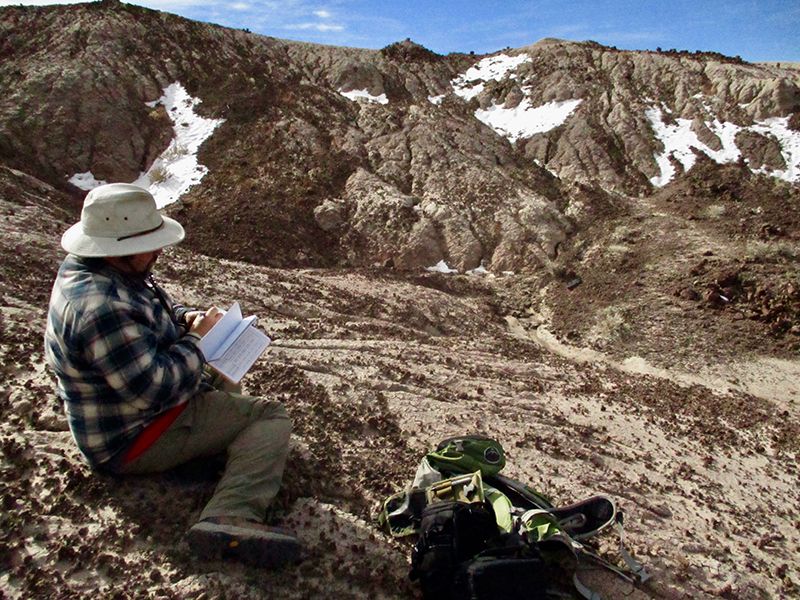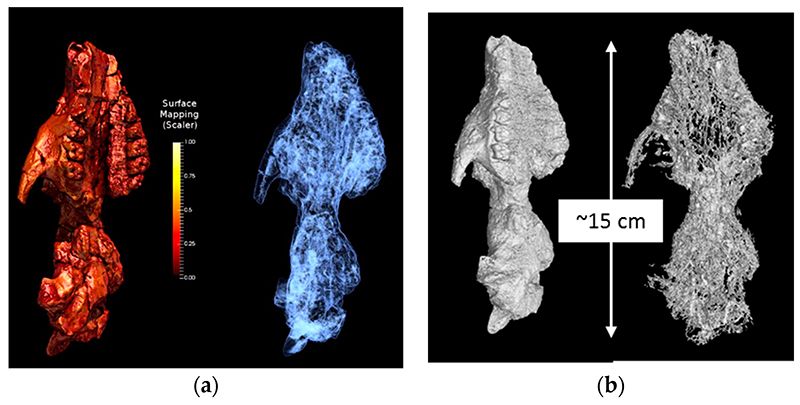Nuclear Technology May Help Bring Early Mammal Evolution Into Focus
Using a neutron scanner at Los Alamos, paleontologists are generating high-resolution imagery of early mammal fossils
/https://tf-cmsv2-smithsonianmag-media.s3.amazonaws.com/filer/53/af/53af1b53-634f-47a3-a0f8-9caaf453c01b/fossils_3.jpg)
When the echoes of dinosaurs crunching through forests and splashing through canyons quieted 66 million years ago during their extinction, the world did not fall silent — mammals scurried and chattered in their shadows, filling voids with new and rapidly evolving species. Scientists think the first placentas appeared around this time, laying the groundwork for the largest group of mammals alive today, including us.
The Paleocene — the epoch following the non-avian dinosaur extinction — marks one of the most important periods of mammal evolution, but researchers don’t understand how and why mammals evolved so quickly during this time. Fast-paced evolution does tend to follow mass extinctions, but scientists don’t understand that pattern either, says Tom Williamson, a paleontologist at the New Mexico Museum of Natural History & Science in Albuquerque. “This is the one we are actually a part of, our own ancestors originated at this time, and it’s really poorly understood,” Williamson says.
That’s why he and a team of six other scientists from the U.S., Scotland, China and Brazil are working together to tease apart dozens of mammal fossils from the first 12 million years after dinosaurs disappeared to create the most detailed early mammal family tree to date. They’ll need to analyze intricate skeletal structures — including ear bones and brain-cases — to differentiate species, but traditional X-ray scans can’t always pick up on these minutiae. So the team has formed a unique partnership with the Los Alamos National Laboratory (LANL) in New Mexico to generate high-resolution imagery using a state-of-the-art neutron scanner. Williamson is the first paleontologist to collaborate in this way with the lab, which has roots in nuclear defense. The partnership demonstrates how nuclear technology that could ultimately wipe us out as a species has also generated innovations, like this neutron scanner, that may help us understand our own origin as a species.
Before dinosaurs disappeared, one of the most common and diverse groups of mammals scurrying around the planet were rodent-like creatures called multituberculates. Some of these survived the extinction, measuring the size of small mice. But new groups of mammals also started to appear after the extinction, and changed rapidly. “You go from a cat-sized mammal to something that is the size of a person in about 300,000 years, which is very fast,” says Williamson, noting that this fast pace is part of what makes this period particularly interesting but also challenging to understand.

To get to a prime field site where Williamson has found ample evidence of this life, we drive several hours northwest of Albuquerque into the badlands of the San Juan Basin. When we arrive, we walk through barren grey hills the color of moon dust that were once the banks of a river. They’re now eroding in the wind, slowly spilling out remnants of an ancient ecosystem. This marks one of the best places in the world to find mammal remains from this time period, Williamson explains as we hike down to a flat depression where he has had particular luck in his decades of fossil hunting.
I start to train my eyes for fossils amidst the rubble on the ground and pick up a piece of whitish-gray rock the size of my fist. It has a directional grain that, to me, looks like it could be a bone. I show it to Williamson and he shakes his head. “Just petrified wood,” he says, not as impressed by a multi-million-year-old tree turned to stone as I am.
Over the next several hours, I train my eyes more acutely and find a slew of other fossils: turtle shells, lizard skin, fish scales, and more. But what Williamson is really after are mammal remains, especially teeth and skulls of animals including Eoconodon coryphaeus—a small cat-sized omnivore capable of climbing—and Pantolambda bathmodon, a sheep-sized herbivore that stayed closer to the ground. He’s after teeth and skulls because other parts of mammal skeletons tend to look strikingly similar if they evolved to withstand the same environmental conditions. “That sort of fools you into thinking they are closely related when they are not,” Williamson explains.
But certain structures, including ear bones, aren’t as susceptible to this so-called convergent evolution because ears aren’t as easily swayed by the environment as other body parts, says Williamson. Tiny holes in the skull where blood vessels and nerves connect the brain to the rest of the body are especially helpful identifiers of different species, says Michelle Spaulding, a paleontologist at Purdue University Northwest in Westville, Indiana involved in the study. “Those can create very diagnostic patterns in the ear region that help us identify what group an animal will belong to,” she notes.
But those holes are tiny and impossible to study with the naked eye, so that’s where the team’s partnership with Los Alamos National Laboratory becomes crucial to the project. The lab operates some of the highest-energy X-ray and neutron scanners in the world that can generate some of the highest-resolution imagery possible, says Ron Nelson, an instrument scientist at the lab’s Neutron Science Center. He tested out the neutron scanner on a large dinosaur skull with Williamson last year, successfully generating the highest-resolution scan of a tyrannosaur skull ever completed. With confidence in the technology, they’ve now transitioned to imaging smaller mammal structures.
Los Alamos National Laboratory was built in 1943 for nuclear defense research associated with the Manhattan Project, the efforts to develop the first nuclear weapons during World War II. Since then, it has increasingly expanded its collaborations with scientists ranging from botanists to physicists, especially in its Neutron Science Center that includes a half-mile long accelerator that generates neutrons — uncharged particles found inside atoms that offer imaging advantages over the electrons used in X-rays.
Whereas X-rays get absorbed by and are good at imaging dense materials, neutrons detect the composition within atoms, regardless of density. That means neutrons can penetrate materials and capture imagery that X-rays cannot. A classic example demonstrating this phenomenon is an image of a rose inside a lead flask. “The neutrons are more sensitive to the flower, so you can image the flower inside the lead,” says Nelson.
Neutron imaging has a variety of applications in detecting explosives and nuclear material. But it also offers new solutions for imaging fossils stuck within and obscured by dense minerals in rocks. Breaking the fossils out of rock would destroy the sample, so neutron scanning gives scientists a non-destructive alternative—though the samples do become radioactive for a period of time after the scan, Williamson notes. His samples are usually safe to handle after a few days, but other materials would stay radioactive for much longer depending on their composition.
Nelson says the partnership with the paleontologists is mutually beneficial, since it challenges the lab to overcome new problems. “By improving our techniques on their samples, we improve the capability we have for other problems we are trying to solve,” he says.

Aside from scanning fossils, the team will look into the chemistry of different species’ teeth to learn more about the climate those animals lived in. The team will also look into data on molecular relationships between modern mammals and how they relate to some of these extinct species. This helps provide a time calibration and scaffolding for the tree, but the molecular data still has many gaps that need to be filled in. That’s why it’s so important to conduct these in-depth fossil analyses, says Anjali Goswami, a paleontologist at the Natural History Museum in London who also studies early mammal evolution but is not involved this work.
“One of the most important things to do is go out and look for fossils and look for new sites that aren’t well understood,” she says, noting that understudied regions in India and Argentina where she works may also help fill in gaps in the puzzle of early mammal evolution.
The resulting family tree will provide a springboard for exploring more details about these ancient creatures, including the different types of landscapes and environments they roamed through, says Spaulding.
“Once we figure out how everything is related, we can start to ask more interesting questions about mammalian evolution,” she says.

